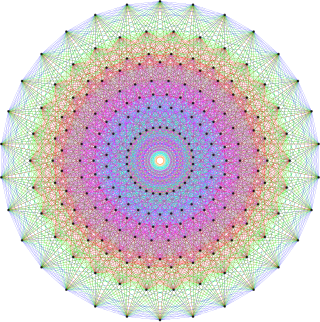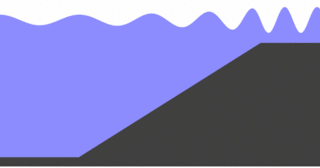In mathematics, especially in category theory and homotopy theory, a groupoid generalises the notion of group in several equivalent ways. A groupoid can be seen as a:
In category theory, a branch of mathematics, a natural transformation provides a way of transforming one functor into another while respecting the internal structure of the categories involved. Hence, a natural transformation can be considered to be a "morphism of functors". Informally, the notion of a natural transformation states that a particular map between functors can be done consistently over an entire category.
In mathematics, specifically category theory, adjunction is a relationship that two functors may exhibit, intuitively corresponding to a weak form of equivalence between two related categories. Two functors that stand in this relationship are known as adjoint functors, one being the left adjoint and the other the right adjoint. Pairs of adjoint functors are ubiquitous in mathematics and often arise from constructions of "optimal solutions" to certain problems, such as the construction of a free group on a set in algebra, or the construction of the Stone–Čech compactification of a topological space in topology.
In category theory, a branch of mathematics, a monad is a monoid in the category of endofunctors. An endofunctor is a functor mapping a category to itself, and a monad is an endofunctor together with two natural transformations required to fulfill certain coherence conditions. Monads are used in the theory of pairs of adjoint functors, and they generalize closure operators on partially ordered sets to arbitrary categories. Monads are also useful in the theory of datatypes, the denotational semantics of imperative programming languages, and in functional programming languages, allowing languages with non-mutable states to do things such as simulate for-loops; see Monad.
In mathematics, particularly algebraic topology and homology theory, the Mayer–Vietoris sequence is an algebraic tool to help compute algebraic invariants of topological spaces, known as their homology and cohomology groups. The result is due to two Austrian mathematicians, Walther Mayer and Leopold Vietoris. The method consists of splitting a space into subspaces, for which the homology or cohomology groups may be easier to compute. The sequence relates the (co)homology groups of the space to the (co)homology groups of the subspaces. It is a natural long exact sequence, whose entries are the (co)homology groups of the whole space, the direct sum of the (co)homology groups of the subspaces, and the (co)homology groups of the intersection of the subspaces.
In mathematics, a comma category is a construction in category theory. It provides another way of looking at morphisms: instead of simply relating objects of a category to one another, morphisms become objects in their own right. This notion was introduced in 1963 by F. W. Lawvere, although the technique did not become generally known until many years later. Several mathematical concepts can be treated as comma categories. Comma categories also guarantee the existence of some limits and colimits. The name comes from the notation originally used by Lawvere, which involved the comma punctuation mark. The name persists even though standard notation has changed, since the use of a comma as an operator is potentially confusing, and even Lawvere dislikes the uninformative term "comma category".
In category theory, a branch of mathematics, a pullback is the limit of a diagram consisting of two morphisms f : X → Z and g : Y → Z with a common codomain. The pullback is often written
In algebraic topology, a branch of mathematics, a spectrum is an object representing a generalized cohomology theory. Every such cohomology theory is representable, as follows from Brown's representability theorem. This means that, given a cohomology theory
,
In mathematics, a triangulated category is a category with the additional structure of a "translation functor" and a class of "exact triangles". Prominent examples are the derived category of an abelian category, as well as the stable homotopy category. The exact triangles generalize the short exact sequences in an abelian category, as well as fiber sequences and cofiber sequences in topology.
In mathematics, specifically in category theory, an exponential object or map object is the categorical generalization of a function space in set theory. Categories with all finite products and exponential objects are called cartesian closed categories. Categories without adjoined products may still have an exponential law.
In mathematical physics, a Grassmann number, named after Hermann Grassmann, is an element of the exterior algebra over the complex numbers. The special case of a 1-dimensional algebra is known as a dual number. Grassmann numbers saw an early use in physics to express a path integral representation for fermionic fields, although they are now widely used as a foundation for superspace, on which supersymmetry is constructed.

In category theory, a branch of mathematics, a dinatural transformation between two functors
In category theory, a branch of mathematics, the diagonal functor is given by , which maps objects as well as morphisms. This functor can be employed to give a succinct alternate description of the product of objects within the category : a product is a universal arrow from to . The arrow comprises the projection maps.
In category theory, a branch of mathematics, a presheaf on a category is a functor . If is the poset of open sets in a topological space, interpreted as a category, then one recovers the usual notion of presheaf on a topological space.
In category theory, a branch of mathematics, compact closed categories are a general context for treating dual objects. The idea of a dual object generalizes the more familiar concept of the dual of a finite-dimensional vector space. So, the motivating example of a compact closed category is FdVect, the category having finite-dimensional vector spaces as objects and linear maps as morphisms, with tensor product as the monoidal structure. Another example is Rel, the category having sets as objects and relations as morphisms, with Cartesian monoidal structure.
In mathematics, it can be shown that every function can be written as the composite of a surjective function followed by an injective function. Factorization systems are a generalization of this situation in category theory.

In mathematics, the classical groups are defined as the special linear groups over the reals R, the complex numbers C and the quaternions H together with special automorphism groups of symmetric or skew-symmetric bilinear forms and Hermitian or skew-Hermitian sesquilinear forms defined on real, complex and quaternionic finite-dimensional vector spaces. Of these, the complex classical Lie groups are four infinite families of Lie groups that together with the exceptional groups exhaust the classification of simple Lie groups. The compact classical groups are compact real forms of the complex classical groups. The finite analogues of the classical groups are the classical groups of Lie type. The term "classical group" was coined by Hermann Weyl, it being the title of his 1939 monograph The Classical Groups.
In algebraic geometry, a derived scheme is a pair consisting of a topological space X and a sheaf either of simplicial commutative rings or of commutative ring spectra on X such that (1) the pair is a scheme and (2) is a quasi-coherent -module. The notion gives a homotopy-theoretic generalization of a scheme.

In fluid dynamics, Green's law, named for 19th-century British mathematician George Green, is a conservation law describing the evolution of non-breaking, surface gravity waves propagating in shallow water of gradually varying depth and width. In its simplest form, for wavefronts and depth contours parallel to each other, it states:
In mathematics, specifically category theory, an overcategory is a distinguished class of categories used in multiple contexts, such as with covering spaces. They were introduced as a mechanism for keeping track of data surrounding a fixed object in some category . There is a dual notion of undercategory, which is defined similarly.















